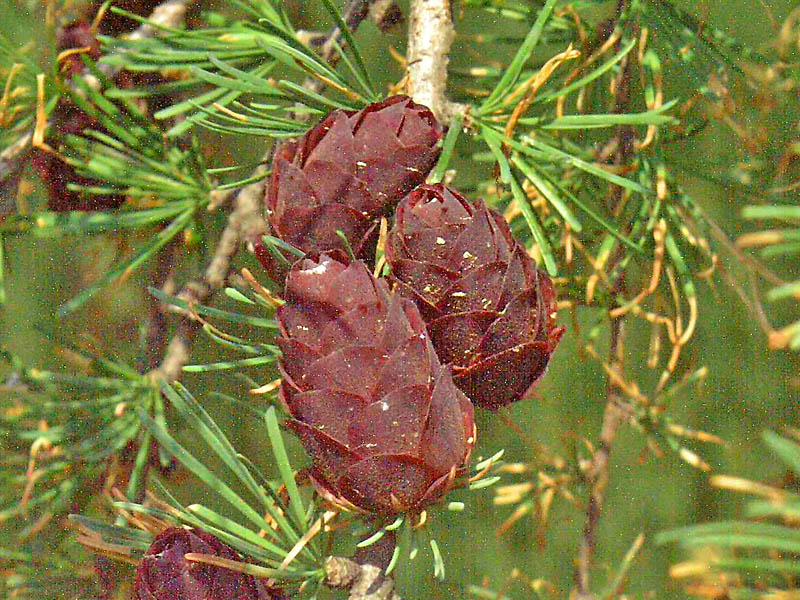
Woody > Larix > Larix gmelinii > Larix gmelinii
Larix gmelinii
Dahurian Larch
Origin: Native to Siberia and northern Mongolia.
Mike's
Opinion


"
This tree is one of the hardiest, northern-most plants surviving temperatures as low as -70°C. Its wood is strong and durable making it good for construction and mine shaft supports. It hybridizes easily with similar species and is very tolerable of harsh conditions; however it cannot be grown easily in North America as even Canada has difficulty giving it the long winter rest it requires. If a botanical garden is looking for a challenge, keeping this tree alive in North America would present that challenge.
Michael Pascoe, NDP., ODH., CLT., MSc. (Plant Conservation)
"
| Family |
| Pinaceae |
| Genus |
| Larix |
| Species |
| gmelinii |
| Category |
| Woody |
| Type |
| Tree (deciduous) |
| Pronunciation |
| USDA Hardiness Zone |
| 1a |
| Canadian Hardiness Zone |
| 0a |
| Temperature (°C) |
| -70C |
| Temperature (°F) |
| -94F |
| Height |
| 10-30 m |
| Spread |
| 5-7 m |
Photographs
Description and Growing Information
Flowering Period
| General Description |
| This tree can withstand some of the coldest temperatures on Earth but is difficult to grow even in North America as Canada’s winters aren’t cold enough. |
| Landscape |
| Plant as a specimen but it is very difficult due to its very low temperature requirements. |
| Cultivation |
| The tree prefers full sun and is tolerant of most soil types and conditions, however it requires a long winter dormancy and in the southern reaches of the northern hemisphere it might be difficult to grow. In England it tends to leaf out in January, the newly emerged leaves are killed by frost and the plant then goes into decline. In its native habitat it does not usually push leaves until May-June after all danger of frost has passed. |
| Shape |
| It commonly reaches heights of 30 m but in exceptional cases heights of 40 m have been reported. l It is broad or cone shaped, usually with a trunk up to 1 m in diameter at breast height. Its branches are normally straight but occasionally drooping. |
| Growth |
| Slow |
| ID Characteristic |
| It has green 2–3 cm long needles that turn a bright yellow before falling in the autumn. The bark is a reddish brown and turns grey as the tree ages. The old cones remains on the tree for many years eventually turning black. |
| Pests |
| Very few pests. Caterpillars of the Tortix family eat the cones. Warmer temperatures however are affecting this tree's natural yearly cycle. |
| Habitat |
| It is found in large monoculture forests growing at altitudes of 50-1, 200 m on permafrost, bogs and mountain soils. It is the most northerly growing tree in the world. |
| Bark/Stem Description |
| The bark of young trees is smooth and reddish brown eventually becoming grey and rougher with age. |
| Flower/Leaf Bud Description |
| Each new shoot bears several buds, the dark brown bud scales are triangularly ovate being 1–2 cm long. |
| Leaf Description |
| Foliage is bright green needles, 2–3 cm long, turning an attractive yellow in the autumn before dropping. |
| Flower Description |
| Flowers are bright pink when in bloom, growing to 6 cm in a spike formation along the shoots: the tree is monoecious. |
| Fruit Description |
| This tree bears 1–2 cm long cones emerging green and becoming brown with maturity. They commonly stay in the tree long after pollination turning grey and eventually black. |
| Colour Description |
| The bark is reddish-brown, greying with age. The needles are green and turn yellow before dropping in the autumn. The flowers are bright pink while the cones emerge green turning brown towards maturity, spent cones persist for several years and turn black. |
| Texture Description |
| A fine textured tree but becoming rigid with age. |
| Notable Specimens |
| Not a popular tree in North America but one in Yakutia, Russia has been recorded to be over 900 years old. |
| Propagation |
| A month of cold temperature stratification (5°C) is required. Plant the seeds in individual pots in late winter and place in a cold frame. By early summer, after a few cm of growth they may be moved outside in partial shade and a protected environment. Plant in the final setting after one full season of growth: the tree transplants easily. |
References
Dahurian Larch. Boreal Forests, n.d. Web. 21 Nov. 2012. .
Larix Gmelinii. Plants For A Future, n.d. Web. 21 Nov. 2012. .

